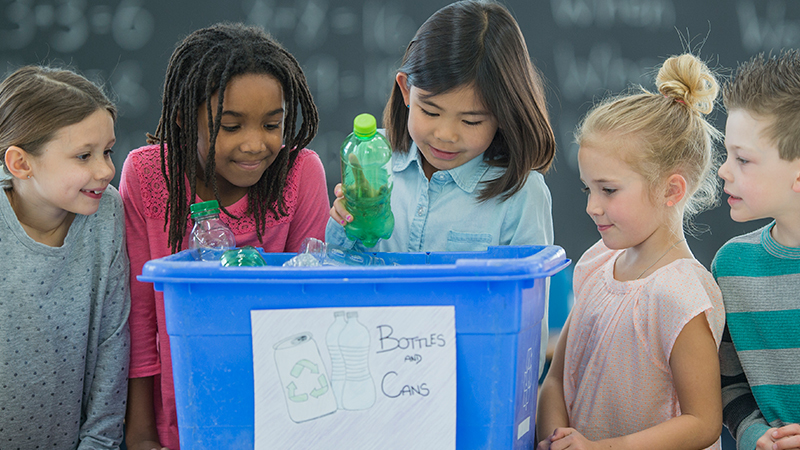It’s an unfortunate fact: schools – and many other organizations and businesses – waste thousands of pounds of paper, plastic, aluminum and food every day. To see how many materials were being thrown out, Minnesota’s state pollution control agency conducted a study, and what they found was shocking. On average, an estimated 483,520 pounds of wasted food, paper and liquids are generated every day at Minnesota K-12 public schools – 78 percent of which is not disposed of properly.
Over the past decade, states across the nation have recognized the tremendous amount of waste produced at schools and have encouraged them to take the lead on recycling. Teachers at all levels have started recycling programs that have changed the way their districts’ waste management operates. One such example is Chris Cunningham, a high school biology and AP environmental science teacher at South Oldham High School in Crestwood, Ky.
What began as a discussion in his AP class about global sustainability evolved into the students wanting to make an impact in their local community. Cunningham gave the class, mostly juniors and seniors in high school, plenty of autonomy to work on solutions to the school recycling problem. Four years later, it has impacted the entire district; the Board of Education now employs a recycling manager in addition to a waste manager district-wide.
Implementing a recycling program in your school may seem overwhelming. We asked Cunningham to share his story and offer advice for starting a program in your school no matter what grade you teach.
Take the First Step
Before you start strategizing, figure out what recycling infrastructure your school has in place. You need to know how the school removes its waste and whether it’s being done efficiently. An informal audit, for example, can help with this. Cunningham said the results of his school’s audit were shocking.
If we can be more efficient, it’s by realizing how inefficient we are. It’s the most important part of it. It’s eye-opening how much one-way through-put waste there is. We came from no program at all. In one week, we filled a dumpster with just paper.
If we can be more efficient, it’s by realizing how inefficient we are.
Once you know the existing infrastructure – whether your school has no program at all or has one that needs to be optimized – a great way to initiate change is by integrating the program into your curriculum. Cunningham used the recycling project as a launching point to discuss big-picture environmental issues with his students, like water pollution, food waste and even deforestation.
If you can work it into your curriculum somehow, that’s the best way. You’ve got a captive audience. You have kids who are going to get involved that, if on their own, maybe wouldn’t have. An English or social studies class could easily talk about societal impact. In math, you can make it into a project. Design a curriculum around it to get kids more invested. It was a lot easier to start having 25-30 kids right off the bat. But (if you can’t integrate it into your curriculum), if you use the school announcement system, you can find the right kids that are interested.
After you’ve gathered enough interested students, ease into the process. Cunningham recommended focusing on one piece of recycling, such as paper, to build consistency and form habits.
If you can start small and get efficient at that, that’s great. Just focusing on one resource, and then building from there is important. When we first started, we had to separate the recycling by hand – the paper from plastic and cans. That was a nightmare! If we had 100 kids, it would have been easy, but some days we had just five total. It’s better to do one thing really well than to try to go for everything right off the bat and get overwhelmed. You can see how things are going and take the proper steps (to keep the program running smoothly).
Get Others Involved
You’ve assembled a group of passionate students, you’ve developed a system – now, it’s time to take your program out of the classroom and bring it to the rest of the school. Utilize the school announcements system to encourage other students to join. Have the school newspaper write a story on your students. Hang signs around school that direct students and teachers on proper recycling (i.e., paper in the right bin, plastic in the left bin). For Cunningham, doing these things not only encouraged more student and faculty participation, but the administration took notice, too. The principal was excited about the program, and he approved expanding the program to include the entire school.
I had my class go out and talk to teachers, students, librarians – everybody. That was really helpful. (These students) formed the core of the club, and they spread word from there. My view is it starts from the bottom. Principals have a million things on their plate – teachers do, too – so our class is (stepping in) to find solutions. (When you get) buy-in from the very top, you can operate an entire school day around a recycling program.
Increasing the amount of recycled materials brings new intricacies to your program, like disposal. What may have been manageable by you and your team on a small scale can quickly escalate to become a new inefficiency, as was the case for Cunningham. Their method of disposal hadn’t caught up to the amount of recycling they generated, and sometimes, they would have to throw recyclables in the dumpster. His class did some research and found a local group that could help.
It started with a very minimal procedure, where (the group) would show up with a truck and a trailer to pick up a tiny bit of recycling. And now, it’s grown; we have a giant dumpster that we take rolling bins to and pour it in there, and a dump truck comes and picks it up. There’s a plant manager at every school, and they’re the ones who are dealing with trash and recycling. There’s now a person in charge of recycling for the entire district!
Set Expectations
Implementing a recycling program is only part of solution; it needs to be maintained. New aspects are always developing, so no one will get bored with this project, and it’s something you can revisit in your lesson every year.
I’ve even had students call the company that does the pickup, just to act as communication liaisons with those people and tell them our needs. For example, something like, “We have a ton of recycling and can’t separate it at all. Can we upgrade to a company that separates it for us?” Even now, I have kids calling and saying, “We need this to be picked up weekly instead of every two weeks.”
One of the best outcomes from the program is how it can benefit students; letting them take ownership of it and fill those leadership roles develops autonomous learners and responsible adults in the future. Cunningham said he could see the initiative sparked in the students from the beginning of the process.
Some students came to me (wanting to start) a program. They had one in middle school that was basically a program the entire school did. If they want to start it, it’s just about spreading the word and getting a core group of teachers (involved). Then, they sort of ran with it.







